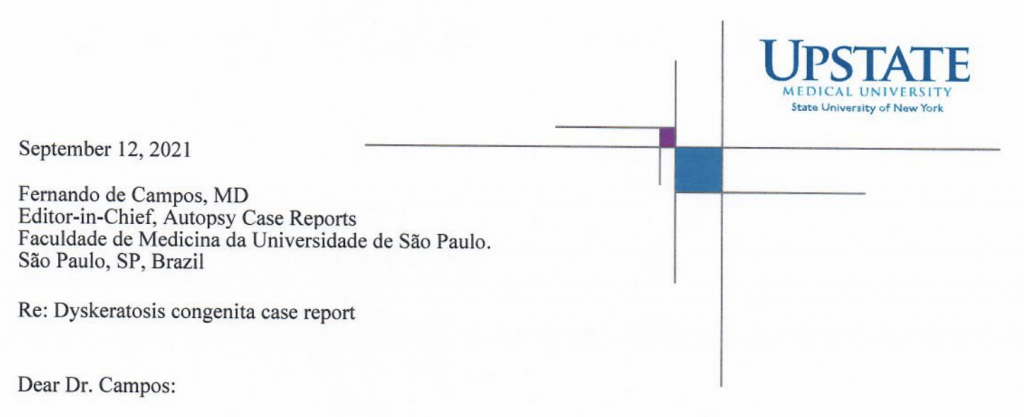
The authors of a case report involving a patient who died of a rare disorder of the bone marrow have removed an image from the article after the person’s mother objected to the use of the photograph.
The paper, “Dyskeratosis congenita,” appeared in Autopsy Case Reports in 2020 and was written by a group from Upstate Medical University, part of the State University of New York system, in Syracuse.
We saw the notice in November and were curious if we could learn more. So we filed a public records request for documents related to the article – and received a response last week disclosing correspondence between Robert Stoppacher, a co-author of the report, and the editor-in-chief of the journal.
In a letter to the journal on Sept. 12, 2021, Stoppacher stated that:
As you know through our prior email correspondence, the mother of the individual in the case report was upset regarding the full-body image (Figure 2A) in the article and requested that it be removed. Although steps were taken to de-identify the individual in the image, the author’s [sic] failed to obtain authorization to include this particular image in the article. This unintentional oversight originated with the authors and not the journal.
It is unclear what “prior email correspondence” refers to; the university said that “email records are generally maintained for only 180 calendar days.”
Stoppacher added in the letter that all four authors of the case study agreed with the decision to retract the image, as did their institution’s ethics committee.
That – minus the part about the mother – is pretty much what the notice states:
The reason for retracting this image is that, although the authors obtained authorization from the deceased’s next-of-kin to perform the autopsy and use the data for publication, this specific picture should not have been included.
This issue was brought to the attention of the journal’s Editor-in-chief by the paper’s corresponding author. After exchanging correspondence with the authors and their institution, the Editor-in-chief obtained a formal letter from the Pathology department at SUNY Upstate Medical University requesting the retraction. The letter states that the four authors of the paper are in agreement with this decision and also that this issue was brought to the attention of the Ethics Committee at the SUNY Upstate Medical University who supports the image retraction.
The Editorial Board and the authors would like to express their most sincere apologies to the family members for this unintentional oversight by the authors.
The letter is signed by Fernando Peixoto Ferraz de Campos, the editor-in-chief of the journal.
The SUNY documents also reveal that the retraction of the image took about two months from the time Stoppacher requested the move – not instant but not the geologic time seen at some journals, either.
Like Retraction Watch? You can make a one-time tax-deductible contribution by PayPal or by Square, or a monthly tax-deductible donation by Paypal to support our work, follow us on Twitter, like us on Facebook, add us to your RSS reader, or subscribe to our daily digest. If you find a retraction that’s not in our database, you can let us know here. For comments or feedback, email us at [email protected].
“. . . the author’s [sic] failed to obtain authorization to include this particular image in the article. This unintentional oversight originated with the authors and not the journal.”
And yet the journal didn’t request any confirmation in writing that permission had been given by the deceased Mother (or any other family member for that matter) that the author(s) of the paper could publish the photograph in question. Seems odd that the journal editors don’t make sure all photographs have the appropriate approvals for publication. Especially photographs of this nature.
Also what’s the point of retracting a paper and removing it from the internet when a copy is easily found archived on a rather well known archiving site. Perhaps journals are going to have to request any archival copies held by this archiving service be deleted if the paper in question is deleted. Just saying.